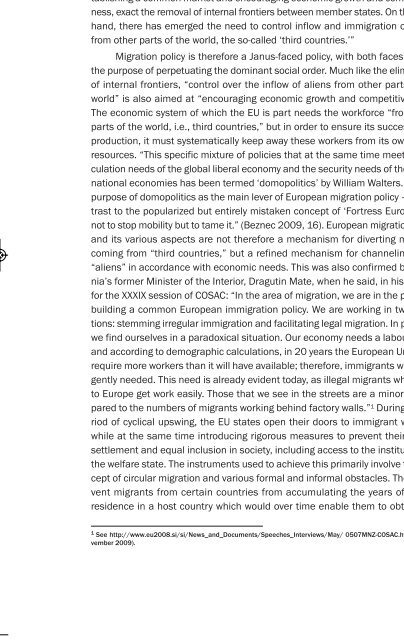The Scars of the Erasure_web
The Scars of the Erasure_web
The Scars of the Erasure_web
- No tags were found...
You also want an ePaper? Increase the reach of your titles
YUMPU automatically turns print PDFs into web optimized ePapers that Google loves.
<strong>Erasure</strong>_4a 10.1.11 20:29 Page 55THE ERASURE AS A TESTING GROUND FOR EUROPEAN MIGRATION POLICIES55<strong>the</strong> Slovenian government stated: “In Europe, which is one <strong>of</strong> <strong>the</strong> global immigrationregions in <strong>the</strong> absolute and relative sense, <strong>the</strong> issue <strong>of</strong> migration policy isone <strong>of</strong> <strong>the</strong> main political issues. On <strong>the</strong> one hand, <strong>the</strong> globalization <strong>of</strong> <strong>the</strong>economies and regional integration efforts, such as <strong>the</strong> European Union, by establishinga common market and encouraging economic growth and competitiveness,exact <strong>the</strong> removal <strong>of</strong> internal frontiers between member states. On <strong>the</strong> o<strong>the</strong>rhand, <strong>the</strong>re has emerged <strong>the</strong> need to control inflow and immigration <strong>of</strong> aliensfrom o<strong>the</strong>r parts <strong>of</strong> <strong>the</strong> world, <strong>the</strong> so-called ‘third countries.’”Migration policy is <strong>the</strong>refore a Janus-faced policy, with both faces serving<strong>the</strong> purpose <strong>of</strong> perpetuating <strong>the</strong> dominant social order. Much like <strong>the</strong> elimination<strong>of</strong> internal frontiers, “control over <strong>the</strong> inflow <strong>of</strong> aliens from o<strong>the</strong>r parts <strong>of</strong> <strong>the</strong>world” is also aimed at “encouraging economic growth and competitiveness.”<strong>The</strong> economic system <strong>of</strong> which <strong>the</strong> EU is part needs <strong>the</strong> workforce “from o<strong>the</strong>rparts <strong>of</strong> <strong>the</strong> world, i.e., third countries,” but in order to ensure its successful reproduction,it must systematically keep away <strong>the</strong>se workers from its own socialresources. “This specific mixture <strong>of</strong> policies that at <strong>the</strong> same time meet <strong>the</strong> circulationneeds <strong>of</strong> <strong>the</strong> global liberal economy and <strong>the</strong> security needs <strong>of</strong> <strong>the</strong> etatistnational economies has been termed ‘domopolitics’ by William Walters. […] <strong>The</strong>purpose <strong>of</strong> domopolitics as <strong>the</strong> main lever <strong>of</strong> European migration policy – in contrastto <strong>the</strong> popularized but entirely mistaken concept <strong>of</strong> ‘Fortress Europe’ – isnot to stop mobility but to tame it.” (Beznec 2009, 16). European migration policyand its various aspects are not <strong>the</strong>refore a mechanism for diverting migrantscoming from “third countries,” but a refined mechanism for channeling <strong>the</strong>se“aliens” in accordance with economic needs. This was also confirmed by Slovenia’sformer Minister <strong>of</strong> <strong>the</strong> Interior, Dragutin Mate, when he said, in his speechfor <strong>the</strong> XXXIX session <strong>of</strong> COSAC: “In <strong>the</strong> area <strong>of</strong> migration, we are in <strong>the</strong> phase <strong>of</strong>building a common European immigration policy. We are working in two directions:stemming irregular immigration and facilitating legal migration. In practice,we find ourselves in a paradoxical situation. Our economy needs a labour force,and according to demographic calculations, in 20 years <strong>the</strong> European Union willrequire more workers than it will have available; <strong>the</strong>refore, immigrants will be urgentlyneeded. This need is already evident today, as illegal migrants who cometo Europe get work easily. Those that we see in <strong>the</strong> streets are a minority comparedto <strong>the</strong> numbers <strong>of</strong> migrants working behind factory walls.” 1 During <strong>the</strong> period<strong>of</strong> cyclical upswing, <strong>the</strong> EU states open <strong>the</strong>ir doors to immigrant workers,while at <strong>the</strong> same time introducing rigorous measures to prevent <strong>the</strong>ir lastingsettlement and equal inclusion in society, including access to <strong>the</strong> institutions <strong>of</strong><strong>the</strong> welfare state. <strong>The</strong> instruments used to achieve this primarily involve <strong>the</strong> concept<strong>of</strong> circular migration and various formal and informal obstacles. <strong>The</strong>se preventmigrants from certain countries from accumulating <strong>the</strong> years <strong>of</strong> “legal”residence in a host country which would over time enable <strong>the</strong>m to obtain per-1 See http://www.eu2008.si/si/News_and_Documents/Speeches_Interviews/May/ 0507MNZ-COSAC.html (27 November2009).


